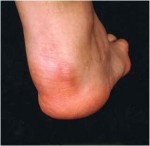Enthesopathy: If it’s not overuse, then what could it be?

In my last post I introduced the enthesis, explaining that it is the site where the tendon (or other soft tissues) joins onto bone (hard tissue) to transmit force, which is either wanted or unwanted. In addition, I highlighted the close relationship between the enthesis and surrounding structures, such as the bursa and fat, forming what is known as the enthesis organ.
I wish now to bring that discussion forward and draw your attention to when things go wrong.
 Google images: Oxford Medicine Online
Google images: Oxford Medicine Online
It is a simple concept to consider that when the forces put through an enthesis are larger than what that structure can withstand, then injury must follow. This is in fact true, and this form of enthesopathy is termed mechanical.
This is often encountered in the sporting population or in those who perform a repetitive task under load. However, I should point out that in this situation the enthesis is less likely to fail than the adjacent tendon or ligament, such that this population is more common to experience a tendon injury, termed a tendinopathy, or a ligament strain or rupture.
So if it is not mechanical, then what could it be?
As a Rheumatologist I wish this question were more frequently considered. That is because there are a number of medical conditions that can affect the enthesis, including most commonly a number of rheumatic diseases and a range of metabolic illnesses such as diabetes, high cholesterol, and other endocrine disorders.
Of the rheumatic diseases, a group of related conditions termed sero-negative arthropathies are characterized by inflammation/injury of the enthesis, termed enthesitis. They are termed sero-negative because those affected do not have an antibody in their blood called Rheumatoid Factor, which is seen in about 70% of those afflicted by Rheumatoid arthritis (which is also a condition associated with enthesitis). Other rheumatic diseases where enthesitis occurs include the arthritis caused by crystals, such as gout, and even osteoarthritis.
The sero-negative arthropathies are comprised of Ankylosing Spondylitis, Psoriatic arthritis, Reactive arthritis, and Enteropathic arthritis. Although as mentioned, they are related by the fact that Rheumatoid Factor is absent they also often share a genetic marker termed HLA-B27. This genetic marker is present in about 90% of those with Ankylosing Spondylitis and about 50% of those with Psoriatic arthritis. However, HLA-B27 is present in up to 10% of the ‘normal’ population and so there are other factors at play that will determine who will develop one of these diseases and who does not. What these factors are exactly is not as yet known, although an environmental agent is probably involved, which is most likely to be an infection (despite the fact that a specific causative infection has not been found). Therefore, the current idea is that these conditions develop in a genetically predisposed host who encounters a particular environmental factor at a time that is just right to trigger the disease.
So why does this sequence of events lead to an immune attack against the enthesis?
Well there are a number of theories but none that are certain. The most popular is that there is a similarity between the factor that triggered the disease and the structure of the enthesis attracting the attention of the immune system.
Whatever it is, what is certain is that the inflammation and injury that occurs at the enthesis results in pain and swelling, such that when the question is asked ‘if it is not mechanical, then what could it be?’; the answer ‘a rheumatic disease, such as a sero-negative athropathy’ should soon follow.
BJC Health established the Sydney Spondyloarthritis Centre in 2011. We raise the profile of these diseases, we provide a better pathway to diagnosis, provide education as well as world-class treatment. Most importantly, we care & we want to improve the lives of people suffering from these diseases.
